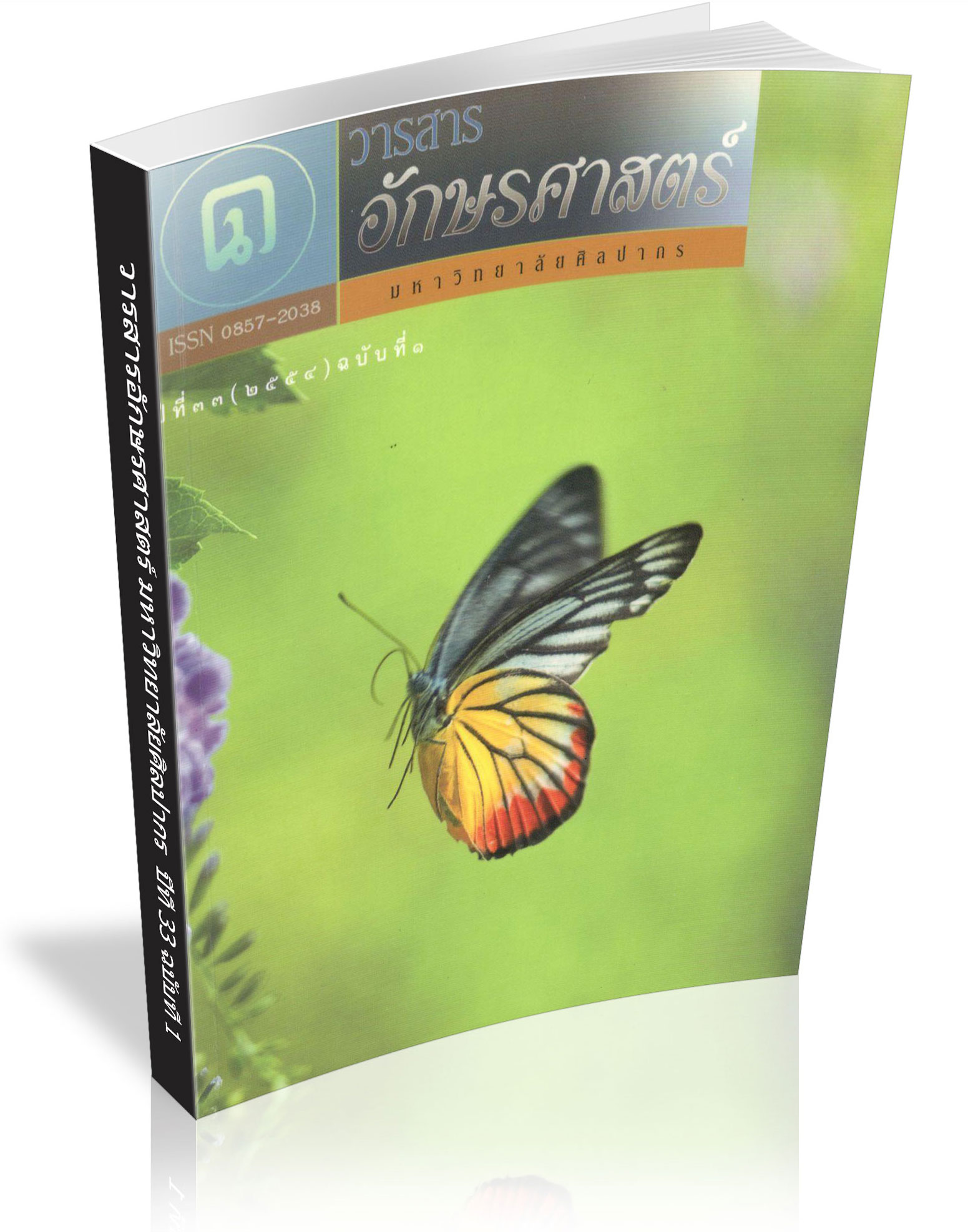คําบอกสีในภาษาจีน
คำสำคัญ:
คําบอกสี, ประวัติความเป็นมา, คําอธิบายความหมาย, โครงสร้าง, คํา, ความหมายและการใช้, สํานวนภาษาบทคัดย่อ
ในระบบคําภาษาจีน คําบอกสีเป็นกลุ่มคําพิเศษที่มีความสําคัญต่อการสื่อสารและมีการใช้บ่อยในชีวิตประจําวัน ซึ่งควรค่าแก่การศึกษาเป็นอย่างยิ่ง งานวิจัยนี้เป็นการศึกษาคําบอกสีพื้นฐาน ๕ สีของภาษาจีน คือ สีแดง “红” hóng สีขาว “白” bái สีดํา “黑” hēi สีเหลือง “黄” huáng และสีเขียว “青” qīng ซึ่งเป็นคําบอกสีที่ใช้บ่อยในภาษาจีนปัจจุบัน โดยมุ่งเน้นศึกษาในด้านประวัติความเป็นมา คําอธิบายความหมาย โครงสร้างคํา ความหมาย การใช้ และสํานวนภาษาที่มีคําบอกสีเหล่านี้เป็นหน่วยคําประกอบในการสร้างคําในภาษาจีนปัจจุบัน ข้อมูลที่ใช้วิเคราะห์ได้มาจากการรวบรวมคําและสํานวนจากพจนานุกรม《现代汉语词典》Xiandai Hanyu Cidian ฉบับปี ค.ศ. ๒๐๐๖ พจนานุกรม《现代汉语规范词典 》Xiandai Hanyu Guifan Cidian ฉบับปี ค.ศ. ๒๐๐๔ พจนานุกรม《新世纪汉语多用词典 》Xin Shiji Hanyu Duoyong Cidian ฉบับปี ค.ศ. ๒๐๐๓ พจนานุกรม《中华成语辞海》Zhonghua Chengyu Cihai ฉบับปี ค.ศ. ๒๐๐๑ และพจนานุกรม 《汉语惯用语辞典》 Hanyu Guanyongyu Cidian ฉบับปี ค.ศ. ๒๐๐๔ ซึ่งมีจํานวนคําทั้งสิ้น ๙๔๗ คํา ซึ่งจําแนกเป็น สีแดง “红” hóng ๑๘๕ คํา สีขาว “白” bái ๒๙๙ คํา สีดํา “黑” hēi ๑๕๓ คํา สีเหลือง “黄” huáng ๑๗๔ คํา และสีเขียว “青” qīng ๑๓๖ คํา มีจํานวนสํานวนทั้งสิ้น ๙๓๔ สํานวน ซึ่งจําแนกเป็น สีแดง “红” hóng ๑๔๖ สํานวน สีขาว “白” bái ๓๑๓ สํานวน สีดํา “黑” hēi ๑๓๖ สํานวน สีเหลือง “黄” huáng ๒๑๐ สํานวน และสีเขียว “青” qīng ๑๒๙ สํานวน
ผลการวิจัยพบว่าคําบอกสีแต่ละคํามีที่มาแตกต่างกัน ในแง่มุมด้านความหมายของคํา คําบอกสีนอกจากจะสื่อความหมายพื้นฐานถึงสีใดสีหนึ่งแล้ว ยังมีความหมายแฝง และความหมายเฉพาะด้านอีกด้วย ส่วนในแง่มุมของการใช้ คําบอกสีนอกจากจะใช้เป็นคําคุณศัพท์แล้ว ยังสามารถใช้เป็นคําประเภทอื่นเพื่อทําหน้าที่ต่างๆ ในโครงสร้างประโยคได้ และยังใช้เป็นหน่วยคํา เพื่อประกอบกับหน่วยคําอื่นเพื่อสร้างคําประสม หรือสํานวนต่างๆ ได้มากมาย ซึ่งล้วนเป็นกลุ่มคําที่สําคัญต่อการสื่อสารในภาษาจีนปัจจุบัน
Downloads
ดาวน์โหลด
เผยแพร่แล้ว
รูปแบบการอ้างอิง
ฉบับ
ประเภทบทความ
สัญญาอนุญาต
ผู้เขียนบทความต้องยินยอมในข้อกำหนดต่าง ๆ ของวารสารก่อนส่งบทความตีพิมพ์




